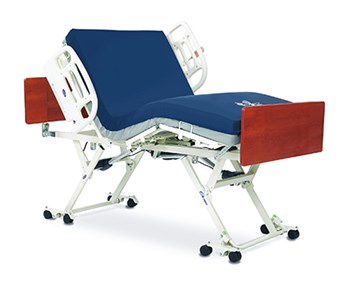When you or a loved one falls ill and develops a need for a hospital bed, you may be overwhelmed by your options. Here are our four best recommendations.
Continue readingWhat Is a Hospital Bed?
Did you recently learn that yourself, or a loved one, needs to secure a hospital bed to assist with recovery or to maximize long-term comfort?
We’re here to guide you through the world of hospital beds and help you navigate the many models and accessories available. In fact, we’re confident that Terry Lesiak, Conval-Aid’s resident hospital bed expert, knows more about these beds—and how to acquire one quickly— than anyone else in the Ottawa area.
ARRANGE TO SPEAK WITH TERRY ABOUT HOSPITAL BEDS
How Does a Hospital Bed Work?

Hospital beds are designed for people in need of some form of specialized health care. Most resemble a twin bed but are much sturdier and offer special features that benefit both the patient and the caregiver.
First and foremost, a hospital bed is adjustable. It features perfectly placed hinges that allow the angle of the head and foot sections of the bed to be repositioned, and you can also change the height of the bed. Electric controls operate all these adjustments.
Additionally, they are built with patient safety in mind. For instance, most have, or can accommodate, protective side rails to help prevent falls that could result in serious injury.
Choosing the right bed can be tricky as there are many models and brands to select from. To get started, ask your healthcare provider or occupational therapist for suggestions. (Or, of course, Terry can answer any questions you might have.)
Electric Hospital Bed
Electric beds are by far the easiest to use because they virtually eliminate the need for manual labour. With the touch of a button, the bed can be changed from a flat position to a seated position.
Some full electric hospital beds are referred to as “high low” medical beds. These beds are recommended for situations where the height of a bed needs to be changed often. For example, a patient might require the bed to be lowered to get safely in and out of bed, while a caregiver needs it to be raised in order to attend to the patient without straining. We’ve found these beds beneficial in situations where weight capacity is a concern, for people with limited mobility and for those suffering from ailments like dementia.
What Size Are Hospital Beds?
Before ordering your bed, assess the space you have available. Generally, these beds take up more space than a twin bed does.
Standard Beds
Each model will be a bit different, but a standard medical bed is approximately 36″ wide (wider with side rails) and 88″ long, with a slightly smaller sleeping area.
Bariatric Beds
Bariatric hospital beds are extra-large and designed to support a higher weight capacity. (They are ideal for patients that weigh between 350 to 1000 pounds.) A scale is often incorporated into these fully automatic specialty beds.
See our recommendations for the best hospital beds for home use to learn more about your options.
How Do I Choose a Hospital Mattress?
If a patient is bedridden or must spend more time in bed than not, the type of mattress you choose becomes very important. To avoid bed sores, you’ll want to select a material that properly distributes a patient’s weight across the surface of the bed. Thankfully, you can pick from gel, foam and air mattresses. Additional padding and mattress covers are offered to improve comfort as well.
Can I Rent a Hospital Bed?
Yes! You can either rent or buy a hospital bed. Renting is a great decision if you know you’ll only need the bed temporarily. However, if you are hoping to obtain a bed for a senior or have a long-term need, we recommend purchasing a bed and mattress.
Unfortunately, there is almost no government funding available for medical beds, so they are often an out-of-pocket expense. That said, some supplemental or employer group insurance plans do reimburse durable medical equipment (DME) expenses up to a certain amount. If you have one of these plans, it’s worth looking into!
Why Work with an Occupational Therapist?
If a patient is recovering from an injury or returning home from a hospital stay, the assigned occupational therapist (OT) is a wonderful resource. With access to medical history records and an understanding of rehabilitation plans, they can make proper recommendations. An OT can also explain other medical equipment that might be required, such as a trapeze (a bar a patient used to lift and reposition themselves with). Conval-Aid works closely with the OT community in Ottawa.
Talk to Terry about Your Hospital Bed Needs
If you have any questions at all, contact Terry. Why? Because he has the answers. And, he’ll do whatever it takes to reduce your stress by making this process easier for you.
You can count on Terry to:
- Carefully listen to you and offer his best advice.
- Walk you through manufacturer websites and discuss the features of various beds.
- Speak with the OT on your behalf.
- Organize a short-term solution for you while you wait for your order to come in.
- Email your invoices and receipts or take your order directly over the phone.
- Arrange for delivery and set-up. (He might even do it himself!)
- Secure a hospital bed for you because Conval-Aid has beds in stock.
With Terry’s help, you can focus on getting your loved one home and comfortably settled in a safe and secure bed.
When To Rent Vs. Buy A Hospital Bed
Sometimes it’s better to rent than buy when it comes to hospital beds. Learn about which option works best for your situation.
Continue reading

